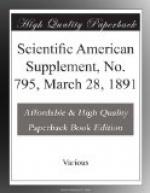A preliminary feeding trial was continued for twenty-five days, during which time both hens and chickens were confined, all together, in a fairly well lighted and ventilated room, and fed a great variety of food, in order that all should go into the feeding trial as nearly as possible in the same condition. During this preliminary feeding both hens and chickens increased in live weight. The ten hens from a total of 44 lb. 12 oz. to 47 lb. 1.5 oz., or 3.75 oz. each, and laid 93 eggs. The chickens from a total of 9 lb. 15 oz. to 18 lb., or 12.9 oz. each.
Food, shells and water were kept constantly before the fowls. Basins which contained the food and water were kept within a box constructed of lath, so arranged that the fowls could reach between the slats and procure food and drink without wasting or soiling.
July 26th the hens and chickens were each separated into two lots of five each, as follows:
Hens, nitrogenous
ration, weighed 23 lb. 8.5 oz.
Hens, carbonaceous
ration, weighed 23 lb. 9 oz.
Chickens, nitrogenous
ration, weighed 8 lb. 15 oz.
Chickens, carbonaceous
ration, weighed 9 lb. 1 oz.
The four lots were placed in separate pens where they remained during the entire experiment, which lasted 125 days. They were fed and watered once daily, and an account kept of the food eaten and water drank. At each feeding the food and water remaining were weighed back and deducted from the amount charged at the previous feeding.
The hens and chickens fed a nitrogenous ration were given daily all they would eat of the following mixture: 1/3 part wheat bran, 1/3 part wheat shorts, 1/3 part cotton seed meal, 2 parts skimmed milk, and will be designated Lot I.
The hens and chickens fed a carbonaceous ration were given daily all they would eat of a ration of cracked maize and maize dough, and will be designated Lot II.
Both groups were given a small amount of green clover as long as it lasted, and afterward cabbage.
For convenience the experiment was divided into five periods of twenty five days.
FOOD CONSUMED AND INCREASE IN LIVE WEIGHT.
During the first period all the fowls seemed in good health except the carbonaceous fed chickens; they, during this as in all succeeding periods, were restless and peevish, always moping or hunting for something to eat, though their trough was filled. When fed they would greedily take a few mouthfuls and then, with their hunger still unappeased, would leave the dish. They always ate ravenously the green food which was given them, as did the hens and chickens of Lot I. The hens of Lot II., on the contrary, seemed quite willing to squat about the pen and subsist on the maize diet, and strangely enough cared little for green food. The clear maize diet was accompanied by such ill effects that the chickens of each lot,




